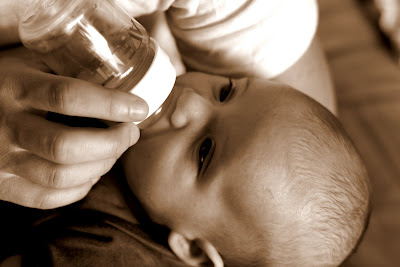These are usually higher gravity beers the beer that has been me certainly falls in that camp: A quad with a very large portion of D2 syrup that resulted in an underattenuated mess. Great fermentation character, bready malty with that complexly stewed prune, almost roasty figginess. And a beer-ruining cloying ~1.035ish sweetness.
Jason tried the same recipe at home, with nearly identical technique and pulled up lame in the same FG ballpark. Thankfully, he didn't chuck his either, and it has spent the better part of the summer and fall making amends with the now available year round Wyeast Roselare blend. Tasted it a week ago, and its got the makings of a sour beast, I can't wait to see where this one ends up. It was so damn delicious, we just forgot to stick it in the hydrometer jar for a reading before it disappeared from our glasses. I've been ultra patient, trusting that its just too early now to even think about it, now that it has the grapes on it.
Anyhow, Jason, Luc and I set out one early morning in October to make right what went oh-so-wrong a few years ago.
That recipe was based on an approximation of the St. Bernadus Abt 12, which purportedly has a very heavy dose of this specialty dark candi syrup, which I'm trying to figure out a way to cook up at home. That cooked sugar, combined with some refined beet sugar combined for ~20% of the fermentables, in order to ensure a properly dry finish. um, right.
In that go-around, I made all the now-obvious mistakes that hindered that goal: less than optimal pitching rate, went with aquarium pump + airstone aeration and not oxygenation and lack of fermentation temperature control.
As my shipment of pils malt was late arriving from the recent mail order, and runs to the homebrew shop are really limited as of late with daddy responsibilities, we sacrificed some of that class pils character and went with some American 2 row as the base grain, so we could just brew some ale.
The tube of Chimay yeast had gotten off to a running start in an ample amount of 1.040 starter wort, and had been spinning round in the stirstarter for 36 hours before pitching.
The D2 was unfortunately in that not-quite-there-yet shipment too, so an across the street run to Trader Joe's for some turbinado was the lame duck sub. Before we started, we thumbed through Brew Like a Monk, and found we had now settled on a close approximation of an included classic recipe, so we felt confident while we weren't going to get to see how far down we could attenuate the prior recipe, we would still end up with a solid beer to ponder the true re-brew.


I did want to bump the IBUs up a touch from the prior batch, perhaps as a knee jerk reaction to compensate from the memory-sticky too-sweet finish, so 3oz of whole leaf Willamette made its way in to a hop sack for a 60minute addition.
As we'll often do, while we wait for the wort to come to a boil, J and I popped some solid bottles, but not before we were sure the little man had what he needed.
The first was a 750ml of 2.5 year old chimay grand reserve, in a study of the malt and yeast profile that was intended from this brew day.
And, if you've been around the house at all, you'll know that one nice bottle can sometimes lead to the popping of another.
Unfortunately, the cooing baby and hubris induced visions of an already vanquished quad brewday convinced me that we had it all under control, until I turned back to the lauter to realize, we had collected too much wort, and diluted a full 20 points below intended gravity! I could only shake my head, foolishly foiled. Oh well, at least that means there'll be just more of this not-quite-quad BSDA.
Fermentation started at 62F, held for 24hours after krausen appeared (sometime that night, pitched late afternoon). Raised to 74F ambient over the next 2 days, then blanketed in fleece to up to 77F for 1 week. Conditioned for an additional 2, then enough cane sugar to bottle to 4 volumes. FG to a respectable 1.016F.
Corked and caged.
| Quad 2010 |
| Belgian Dark Strong Ale |
Type: All Grain | Date: 10/11/2010 | ||||||||||||||||||||||||||||||||||||||||
Batch Size: 5.50 gal | Brewer: Jason | ||||||||||||||||||||||||||||||||||||||||
| Boil Size: 6.30 gal | Asst Brewer: JC | ||||||||||||||||||||||||||||||||||||||||
| Boil Time: 60 min | Equipment: My Equipment | ||||||||||||||||||||||||||||||||||||||||
| Taste Rating(out of 50):35.0 | Brewhouse Efficiency: 75.00 | ||||||||||||||||||||||||||||||||||||||||
| Taste Notes: | |||||||||||||||||||||||||||||||||||||||||
Ingredients | |||||||||||||||||||||||||||||||||||||||||
| |||||||||||||||||||||||||||||||||||||||||
Beer Profile | |||||||||||||||||||||||||||||||||||||||||
Est Original Gravity: 1.113 SG | Measured Original Gravity: 1.092 SG | ||||||||||||||||||||||||||||||||||||||||
| Est Final Gravity: 1.026 SG | Measured Final Gravity: 1.016 SG | ||||||||||||||||||||||||||||||||||||||||
| Estimated Alcohol by Vol:11.52 % | Actual Alcohol by Vol: 9.97 % | ||||||||||||||||||||||||||||||||||||||||
| Bitterness: 33.4 IBU | Calories: 425 cal/pint | ||||||||||||||||||||||||||||||||||||||||
| Est Color: 20.5 SRM | Color:
| ||||||||||||||||||||||||||||||||||||||||
Mash Profile | |||||||||||||||||||||||||||||||||||||||||
| Mash Name: Single Infusion, Light Body | Total Grain Weight: 20.50 lb | ||||||||||||||||||||||||||||||||||||||||
| Sparge Water: 0.00 gal | Grain Temperature: 72.0 F | ||||||||||||||||||||||||||||||||||||||||
| Sparge Temperature:168.0 F | TunTemperature: 72.0 F | ||||||||||||||||||||||||||||||||||||||||
| Adjust Temp for Equipment: FALSE | Mash PH: 5.4 PH | ||||||||||||||||||||||||||||||||||||||||
| |||||||||||||||||||||||||||||||||||||||||
| Mash Notes: Simple single infusion mash for use with most modern well modified grains (about 95% of the time). | |||||||||||||||||||||||||||||||||||||||||
Notes | |||||||||||||||||||||||||||||||||||||||||
| collected too much wort. | |||||||||||||||||||||||||||||||||||||||||







































































